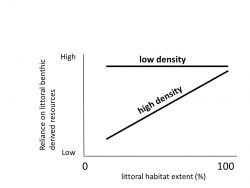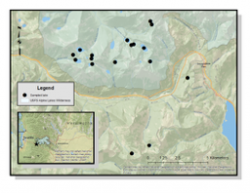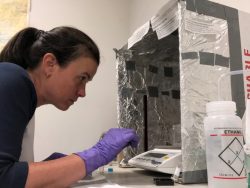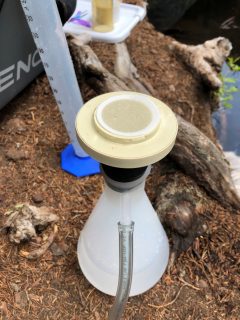by Beka Stiling, MS candidate, School of Aquatic and Fishery Sciences, University of Washington

Variability in reliance on littoral-benthic derived resources by rainbow trout may be partially explained by an interaction between rainbow trout population density and littoral zone extent.
Evidence suggests that the integration of energetic pathways via the transfer of resources across habitat boundaries can influence community structure, maintain species biomass, and promote food web stability. Despite our ability to measure resource integration, we do not have a strong understanding of the factors that determine the varying degrees of resource integration that we observe in fish.
In lakes, the carbon that serves as the energetic base of the food web originates in three distinct habitats: pelagic (open water), littoral-benthic (submerged, illuminated edge), and terrestrial (land surrounding the lake). Fish, as mobile consumers, can use resources derived from different habitats, thereby integrating resources from multiple energetic pathways. Floating algae, or phytoplankton, has long been recognized as an important base of aquatic food webs, but increasing evidence points to attached littoral-benthic algae as a substantial contributor of energy to lake food webs as well. Discussions are ongoing about the role of terrestrial carbon, exported from the surrounding watershed into the lake, as a basal resource for aquatic communities.
My study aims to identify factors that might drive resource integration by rainbow trout in order to better anticipate how alterations to lake littoral habitat from human use and climate change may impact lake ecosystem function in the future. I am testing two potential factors. The first is resource availability. Do fish integrate resource pathways in ratios that reflect the relative extent of the habitats providing carbon to the ecosystem? The second factor is population structure. Does the density of the rainbow trout population influence how fish might rely on different energetic pathways?
To address the challenge of focusing on just two of the many interacting factors that may influence resource integration, I selected study lakes that were similar with respect to climate, geology, human impacts, and species composition, but differed in terms of littoral habitat availability and rainbow trout population structure. From these 17 lakes I collected rainbow trout and samples of primary producers from the pelagic, littoral-benthic, and terrestrial habitats. In the lab I am conducting analyses that leverage naturally occurring differences in molecules formed in these three habitats to elucidate rainbow trout reliance on energy that originated in each habitat.

The study lakes, located on the western side of the Cascade crest, are naturally fishless mountain lakes stocked with rainbow trout at varying numbers and frequencies, resulting in a gradient of fish population densities.
After I analyzed a subset of my samples, preliminary findings revealed an interaction between habitat availability and rainbow trout density, where at low densities rainbow trout are more reliant on littoral-benthic derived resources regardless of littoral habitat availability, but, as population density increases, reliance on littoral-benthic resources decreases with reduced littoral availability. This interaction between factors suggests that for rainbow trout the utilization of multiple pathways may be a solution to competitive pressure on a preferred resource pathway — an example of how resource integration can contribute to the stability of a top predator population.

Beka weighs out samples on a microbalance in preparation for stable isotope analysis.
My next steps are to wrap up my lab-based processing and begin to analyze the full complement of my data. I am excited to uncover the full story and see if the trends I found with a subset of my samples persist! I am thankful to the Washington State Lake Protection Association for the Dave Lamb Memorial Scholarship funding that supports this project. The scholarship funding jump-started my field data collection and provides critical assistance for lab-based sample processing.
Email: stilir@uw.edu
Twitter: @rebekahstiling
Beka Stiling is an MS Student in the School of Aquatic and Fishery Sciences at the UW, advised by Julian Olden and Gordon Holtgrieve.










